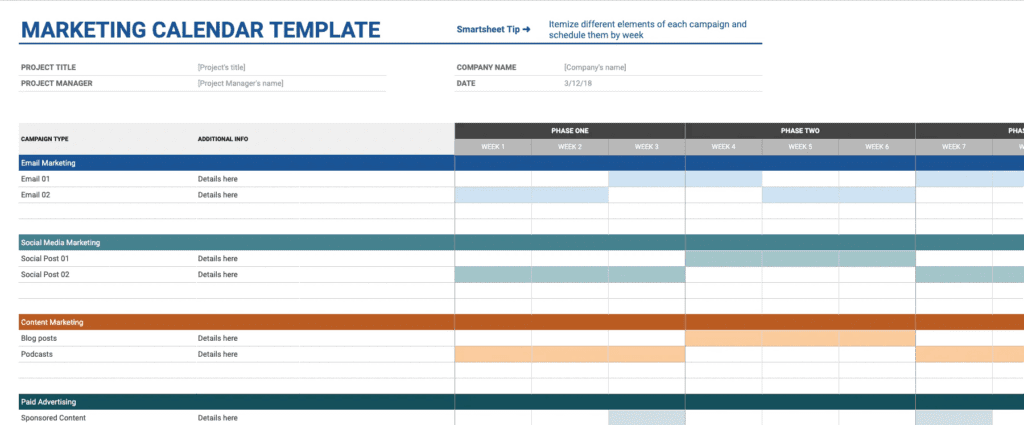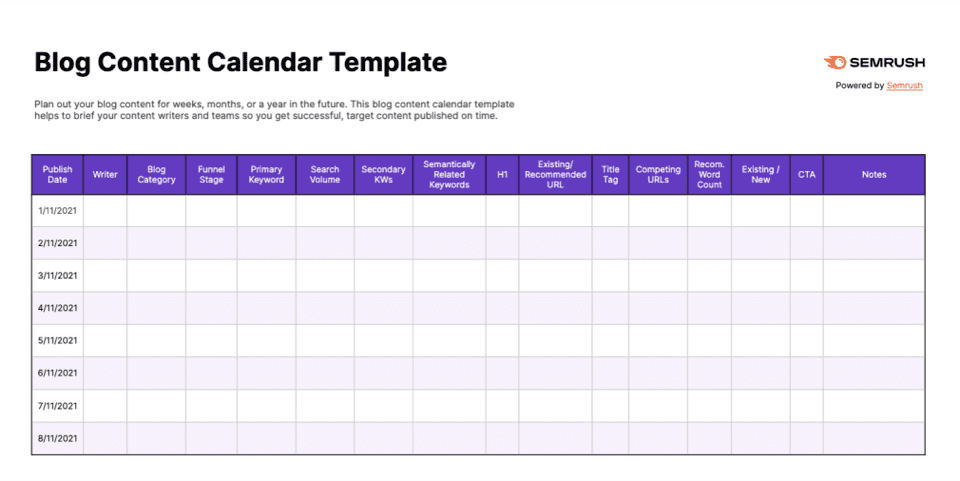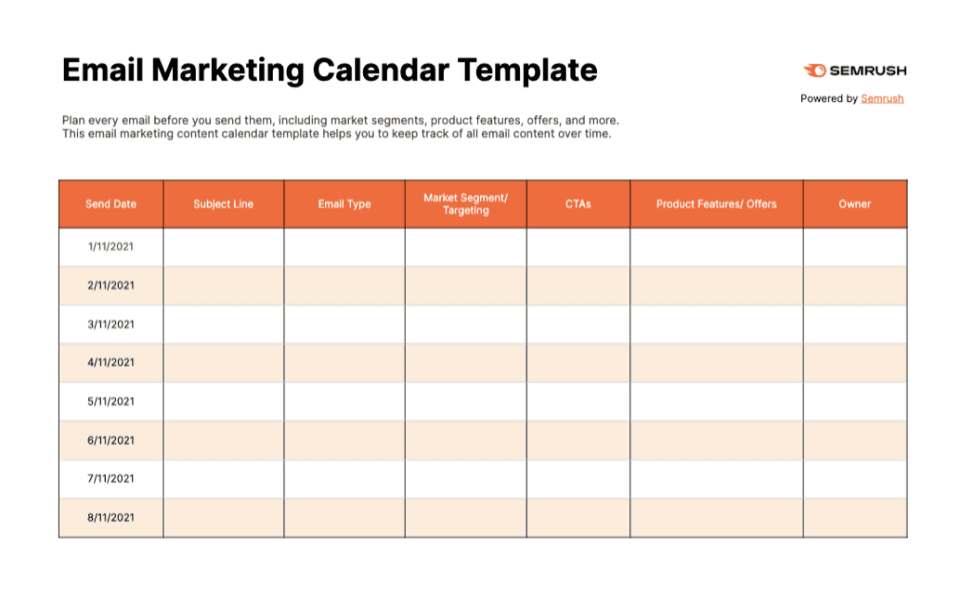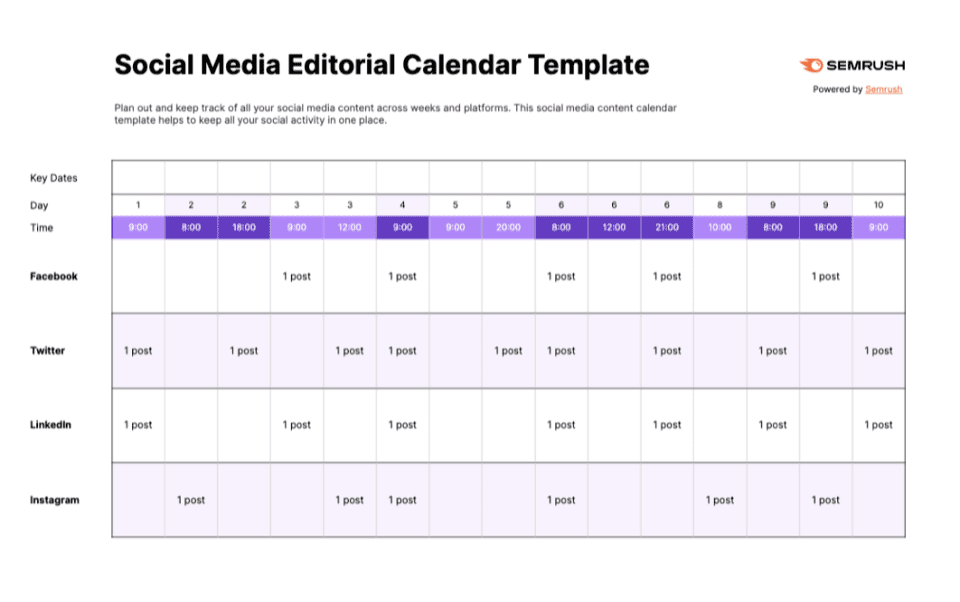
An effective marketing calendar can make or break your content strategy. The right plan will guide your efforts and help you reach your marketing goals, but a poorly designed calendar can result in missed opportunities and wasted effort.
The driving force of any winning strategy is relevant and useful content. Not only should your marketing efforts connect with customers and drive conversions, but they should also keep up with holidays, trends, and changes in consumer preferences.
It can be challenging to create an effective content calendar that both keeps your goals in focus and allows for flexibility as new trends emerge. Yet a little planning goes a long way. Organized marketers are more than seven times as likely to report success as those with no plan.
See how creating an effective content calendar can elevate your marketing strategy.
Table of Contents
What Is a Marketing Calendar?
Whether you keep it in a spreadsheet, a project management software, or an old-fashioned notebook, a marketing calendar is simply a written plan for your upcoming marketing publications. It helps you organize your quality content, social media posts, and other marketing activities in order to achieve the best results.
To achieve the objectives you’ve set for your organization, you have to set goals, which is why creating a marketing content calendar is something you can’t neglect. Creating a marketing calendar displays your goals so everyone on your team can share accountability and accomplish the necessary steps.
What Every Marketing Calendar Must Have
From helping your team meet deadlines to keeping you organized, a marketing calendar is vital to the success of your marketing campaigns and objectives. Here are a few items that every content calendar should have—and why they are important.
1. Point People
Who is assigned to a task to make sure it gets done? Human resource management starts with effective delegation.
A strong marketing content calendar not only helps project managers maximize their employees’ time, but it also helps you anticipate slowdowns in the production process. For instance, if you’re tasking multiple assignments to the same in-house designer, a content calendar can help you stay on the same page about when each item will be ready.
2. Deadlines
Not only does an effective marketing content calendar help you make sure you’re meeting your goals, but it also helps you achieve your objectives on time.
Setting deadlines keeps you motivated and ensures you stay focused on the right content marketing tasks. Plus, regularly publishing content according to the deadlines in your content planner helps you build trust with followers.
In contrast, failing to meet deadlines could lead to delayed marketing campaigns, missed opportunities, and not realizing your content’s marketing goals.
3. Strategic, Cohesive Campaigns
Effective planning helps you avoid thrown-together, disjointed, or reactionary content. Use this opportunity to make a cohesive plan.
Learning how to create a content calendar with quality, relevant content can help build brand awareness. In fact, brand awareness is one of the most commonly cited goals for content marketing, and a calendar can help you get there without seeming obnoxious to your audience.
Choose a theme to coordinate your on-site and off-site promotion. Video production, social media, blogs, and landing pages should all have consistent messaging and branding, and a calendar streamlines these efforts.
4. Backup Plans
Creating a content marketing calendar allows your company to focus on solving challenges in advance, rather than addressing them with half-baked, last-minute solutions. Still, it’s advisable to not put all of your marketing eggs in one basket.
For instance, if you’re working on marketing materials for a new product launch but that product is unexpectedly delayed, you don’t want your website and social channels to go dormant while you scramble to find a plan B.
But if you already have another series of posts in production, you can likely just rearrange the publish dates to accommodate the change in schedule.
Creating your marketing content calendar ahead of time helps you make sure you have enough content or the right people on hand when something unexpected happens. Generally speaking, larger companies prepare and schedule their content calendars 12 months in advance. Even if you can only plan three or four months in advance, having multiple ideas will give you greater flexibility and resources.
Sub-Components of Marketing Calendars
Once you’ve strategically assigned point people with deadlines—and given yourself some backup plans—it’s time to consider the content itself. While your creative team may work from one master calendar, some sub-components can help teams work most efficiently.
Master Marketing Calendar
This marketing calendar provides you with an overview of your marketing content and strategy for a given period, usually a month, quarter, or year.
It covers all forms of marketing your business will be doing. These include content marketing, social media marketing, and more. You can also use this marketing calendar to keep track of market research your business has conducted as well as presentations and outcomes of new approaches.

Source: Shopify
Blog/Editorial Calendar
An editorial calendar—or blog marketing content calendar—is one of the sub-components of an overall marketing calendar. It includes all the blog content and copy that a company would like to publish on its website.
Why does this need to be separate? Usually, long-form written content has a longer production timeline. While an in-house creative team may have a mockup for a social media post done within the hour, thoughtful blog content takes a longer time to research, develop, fact-check, and optimize.
Because blog content is a great way to inform, entertain, and build trust with potential customers, learning how to create a blog content calendar is important. It should include the dates, times, title tags, meta descriptions, images, sources, and persons responsible for all blog content that is scheduled to be posted on your business’s site.

Source: Semrush
Whether your company works with in-house writers or freelancers, the more clarity you can share about sources to use and directions for the topic, the more easily blogs will align with your overall content marketing strategy.
Email Marketing Calendar
Similar to a blog marketing calendar, an email marketing calendar contains all the content you plan to send to email subscribers. Again, why is it separate? Email marketing often utilizes A/B testing or targets particular segments of your audience, whereas blogs cast wide nets for organic reach. The different goals will naturally mean slightly different approaches to your content topics, and it’s helpful to organize these aspects of your campaign separately.
Creating a content calendar for email starts with the customer. Considering that the average open rate for emails across all industries is only about 21%, you want to use your email marketing calendar to send out emails that will invite action. If you’re taking new customers through a drip campaign, consider those emails as well so you are not sending duplicate (or conflicting) content. The best way to manage this is with a calendar.

Source: Semrush
Social Media Marketing Calendar
Lastly, social media needs its own calendar. Learning how to use social media and create a content calendar for your various channels can help your business build leads and generate income—but the time horizon is different than with evergreen blogs or seasonal emails.
A social post may be outdated within a matter of days or even hours. For this reason, planning ahead on social media looks different than with blogs or emails. Social media requires significantly more flexibility and attention to trending topics.
With 41% of small companies relying on social media to drive income, it’s important to have a marketing content calendar that does more than just send messages like “Happy Wednesday!” or “Buy Our Product!” A smart strategy will invite follower engagement and take advantage of useful metrics. For example, if most of your engagement is coming from customers on the West Coast, you will want to post in windows that maximize visibility in Pacific Time.

Source: Semrush
Useful Tips
What’s included in your marketing content calendar certainly depends on your goals and objectives. And there are a few traits of an effective marketing calendar to keep in mind, as well as things to avoid.
- Remember to take holidays into consideration by planning early. The middle of November is too late to start planning a Black Friday sale.
- Include start dates and end dates for promotions so your team knows when to move on to the next campaign.
- Make sure everything on the calendar has a purpose, and avoid cluttering the calendar with information that doesn’t have a goal.
- Work on all related components before launching a new campaign. For example, a paid advertising push may fall flat if you don’t have an optimized landing page first.
Marketing Calendar Software and Tools
While there are some common tools, an effective marketing content calendar is the one you’ll actually use. Choose an application that everyone on your team is already familiar with and can access easily.
Calendar App: Google Calendar is great for keeping track of everyone’s schedule (including meetings) and when marketing content is to be released.
Spreadsheets: Spreadsheets, like Google Sheets, are excellent for keeping content calendars and information all in one place, allowing everyone to view and make changes as necessary.
Content Management and Organization Systems: Content management systems (CMS) for websites, like WordPress, help you schedule blog content and edit or optimize them later on. On the other hand, social media management platforms, like Buffer or Hootsuite, help you manage and organize marketing content across various social media channels. They even include calendars for scheduling marketing content, allowing you to input social media content there once it’s been approved for distribution.
If you’re just getting started with creating content, using the aforementioned social media management apps can help you learn how to create a content calendar
Conclusion
Creating a strategic and systematic plan for your marketing activities can help you cut through the noise and stand out in this competitive landscape. Content that is relevant, useful, and compelling can help you achieve this. But content alone isn’t enough. You need an effective marketing calendar to help your business achieve its content marketing goals.
Founded in 2009, Coalition Technologies is an industry-leading digital marketing agency with extensive experience and success in delivering metrics-driven marketing services to our clients. Contact us today to discover how our experts can help you build an effective marketing content calendar to help you reach your business goals.


